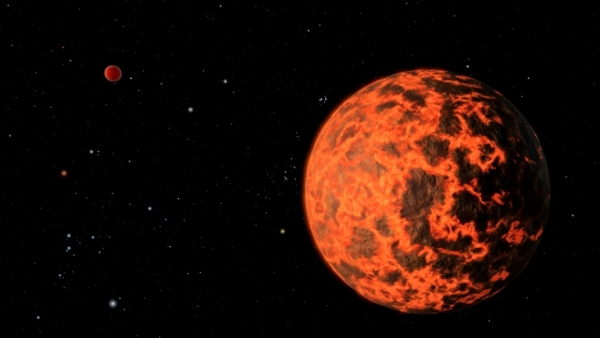If you read science fiction or science fact, you know the nearest star to the sun is called Proxima Centauri, a tiny red dwarf that happens to lay on this side of its triple star system containing Alpha Centauri A and B. Since its so close, astronomers have been able to mostly eliminate the chances of a really large unseen companion in close orbit around the little star, like a brown dwarf or a hot Jupiter. But the possibility of smaller planets exists and there’s reason to think there could be a few. Now, astronomers may get a chance to find out:
HNGN — “Proxima Centauri’s trajectory offers a most interesting opportunity because of its extremely close passage to the two stars,” said Kailash Sahu, an astronomer with the Space Science Telescope Institute in Baltimore. Md. Sahu leads a team of scientists whose work he presented Monday at the 222nd meeting of American Astronomical Society in Indianapolis.
According to Northwestern College, though red dwarfs make up for more than 50 percent of stars in the Milky way, not one of them is visible to the naked eye in the northern hemisphere. Previously, scientists have tried looking for planets around the Proxima Centauri but have not been successful. However, scientists are hopeful that this rare stellar alignment will give them the opportunity to spot smaller terrestrial planets, if they exist, by looking for microlensing effects.
The reason we think this red dwarf could have a healthy retinue of planets is because we know other red dwarfs do have them. Particularly Gliese 581, which is now thought to have almost half a dozen worlds, some of them are probably terrestrial and we know two of those are in or near the habitable zone where liquid water could exist on the surface of an earth-like planet. What might a really watery world in close orbit about such a star look like?
Maybe something like that. The thing about these little red dwarfs is they tend to be very active. Lots of flares, tons of coronal ejections, which means great showers of energized particles hitting the top of the planet’s atmosphere causing all sorts of displays. Made even more intense because the water planet would have to be very close. In the case of Proxima it would have to be so close its “year” would last about a week or less. The good thing about that is it means the planet’s day would be about the same, any world would be tidally locked, and that might be fast enough to preserve a magnetic moment which would deflect some charged particles, a necessity for any nearby world that wanted to hang onto its atmosphere.



That would be sweet. I refuge near the next red dwarf is the perfect plan to survive past the next 4 billion years of solar evolution. Also, violet skies full of auroras? Sign me up :D
How would the air and water stay unfrozen on the back of a tidally locked planet? The atmosphere would have to be pretty thick.
Why do you assume that it would stay unfrozen? It quite possibly wouldn’t. Infinite winter sports possibilities there…
“preserve a magnetic moment which would deflect some charged particles, a necessity for any nearby world that wanted to hang onto its atmosphere.”
I keep running into the claim that a strong magnetic field helps to hold onto a worlds atmosphere, without ever seeing any justifcation for believing it. In light of the thick atmosphere around Venus, which totally lacks a magnetic field, I rather doubt this claim.
Can anyone point me to a discussion of this idea giving reasons to believe it?
Lofty: If earth had one side always day & the other always night, there would be thick glaciers on the night side, but that would only lower sea level a km or 2 out of 4 to 5 km ocean depth. That would leave plenty of wide seas for aquatic life & to provide moisture for rain on the land.
Jim that’s a good question, paradoxically there is a strong school of thought that it was Venus losing it’s mag field billions of years that helped lead it to it’s infernal demise. As the sun heated and Venus’s rotation slowed (Actually, Venus’s rotation is totally fucked up but that’s a different story) charged particles would have broken through, then broken down water vapor into oxygen and hydrogen. The hydrogen escaped leaving reactive oxygen behind to form everything from CO2 to acids. A hotter sun and more GHG’s lead to a hotter world. As the planet heated even more whatever oceans it had were evaporating feeding the process, until the the remnants of the Venusian ocean now resides in its atmosphere in a highly derived form.
But yes, it’s not controversial that a healthy mag field deflects charged particles away from a straight line path, it’s a well understood principle in atmospheric and planetary physics. There is some debate over how much effect that had on various worlds, espscially Venus and Mars, how long it lasted, when it began, etc.
I’ve seen something recently about a tidally locked planet, I think it was called “Alien Worlds”. It suggested that a heat exchange from air currents could make the dark side warmer, although probably still a bit on the nippy side.
Great article here – cheers & shared.
I vaguely recall reading a few (small) articles before on searching for Proximan planets that have turned up short but still.
Yes but being pedantic that’s only presently and NOT on average distance – assuming it does orbit both hotter partners though given Proxima is 13,000 AU from the primary stars and its orbit takes millennia I admit that’s a bit of a nit.
(Which is almost certainly the case although I have read somewhere of some doubts being expressed on this point.)
@ ^ Missing asterisks there for :
assuming it does orbit both hotter partners*
&
* Which is almost certainly the case.
Sorry.
@6. davidmc :
Could you elaborate any further on that source – author, date, text online or magazine article please?
I’d guess that would depend on a range of factors / variables incl. how fast the wind speeds were, exactly how close to the star and therefore heated the world got, the geographic barriers (eg. mountains, single super-continents like Pangea or multiple continents or isolated islands) , the presence of other exoplanets/ brown dwarfs /stars in the system+ large or small which could complicate the motions and /or even contribute to heating and so forth. Complicated equations – wonder if anyone’s done much modelling of them?
+ Of course that’s speaking in general terms. For Proxima Centauri specifically we can rule out other nearby large planets or stars although I wonder what impact Alpha Cen A & B would have – probably not a lot admittedly with them most likely being too distant and star-like from any Proximan HZ worlds but still.
@1. Tyrant al-Kalām :
Just remember that these red dwarfs incl. Proxima Centauri are known for their dramatic stellar flares as well. As Stellar expert Jim Kaler noted :
Could make life interesting!
Just be careful about the mind worms. They are extremely dangerous.
StevoR, I can’t I’m afraid, other than that it was one of these CGI documentary type things, it did have interviews with (seemingly to me, no expert, but not completely gullible) plausible scientists, imagining what life might be like, on a variety of different types of planet, more/less water, gravity etc. Memory is terrible, cant even remember what channel it was on, sorry.
One thing to remember though is that the stars are all in motion, so we must consider the relative motion of the Centauri system with Sol over time.
In 4 billion years the Centauri stars might not be that close anymore….